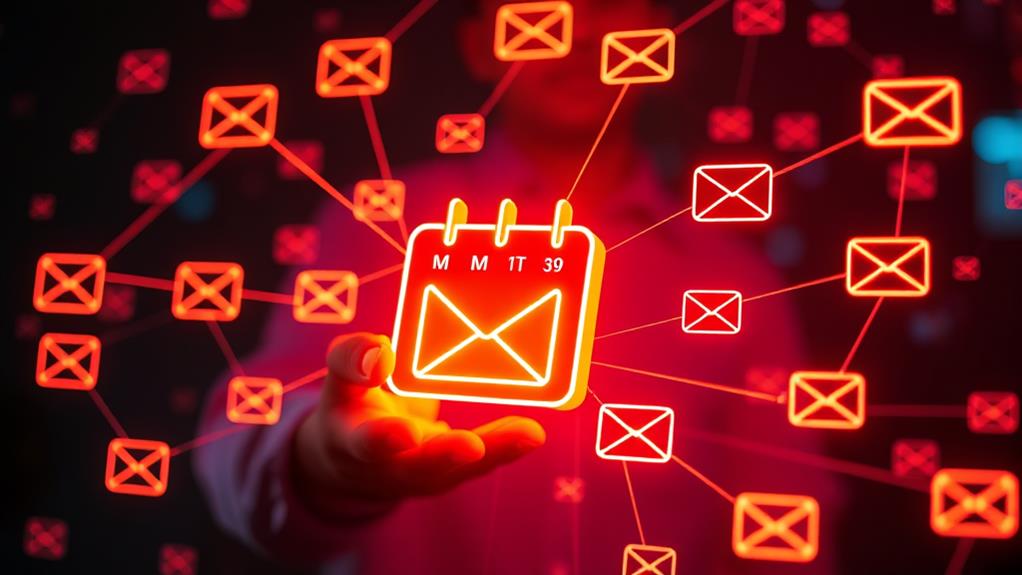Maintaining email list hygiene is essential for enhancing engagement rates and amplifying marketing success. With email decay averaging 22.5% annually, regular list cleansing can reduce bounce rates below 3-5%, improve deliverability, and guarantee up to 79% of emails reach inboxes. Strategic maintenance includes removing inactive contacts, employing double opt-in methods, and using email validation tools. Segmentation based on engagement levels allows for personalized campaigns, boosting ROI by as much as eight times. Through these practices, marketers can optimize expenditures and safeguard reputations, driving stronger campaign results. There are additional methods to further refine these strategies.
Key Takeaways
- Regularly remove inactive subscribers who haven't engaged in 3-6 months to maintain list health.
- Use email validation tools to verify email addresses and reduce bounce rates.
- Implement double opt-in methods for new subscribers to enhance list quality.
- Segment lists based on engagement levels for personalized and targeted content strategies.
- Conduct annual or biannual list audits to ensure accurate and up-to-date subscriber data.
Importance of Email List Hygiene
In the domain of digital communication, diligence in email list hygiene is not merely a best practice but a strategic imperative. With email decay occurring at an average rate of 22.5% annually, organizations must proactively manage their subscriber lists to sustain engagement and optimize performance.
A well-maintained email list is vital for ensuring that communications reach their intended recipients, as poor hygiene can result in approximately 20% of emails failing to hit inboxes. High bounce rates, exceeding 3-5%, can further erode deliverability, emphasizing the need for regular list cleansing.
This not only mitigates the risk of deliverability issues but also enhances subscriber engagement by removing uninterested or inactive contacts. Such practices are essential for reducing spam complaints and bolstering open and click-through rates—key metrics in measuring the success of email campaigns.
Moreover, a clean email list directly impacts the bottom line. Email service providers typically charge based on subscriber count, so maintaining a streamlined list can lead to reduced sending costs.
Ensuring effective list hygiene is a vital strategy for enhancing communication precision and maximizing the return on investment in email marketing efforts.
Benefits of a Clean Email List
Maintaining a clean email list is paramount for enhancing sender reputation and improving deliverability rates, as evidenced by studies indicating that poor list hygiene contributes to nearly 20% of emails failing to reach intended inboxes.
By guaranteeing regular list hygiene practices, businesses can maintain bounce rates below the critical 3-5% threshold, thereby safeguarding their sender reputation and minimizing costly spam complaints.
In addition, a well-maintained list not only guarantees higher deliverability but also optimizes marketing spend by reducing expenditures on unengaged recipients, leading to more effective and efficient email campaigns.
Improve Sender Reputation
Enhance your sender reputation by prioritizing a clean email list, a strategic move that addresses the staggering fact that nearly 20% of emails fail to reach their intended inboxes due to poor list hygiene.
By focusing on sender credibility and effective reputation management, businesses guarantee their communications are not only delivered but also received favorably by recipients and Internet Service Providers (ISPs).
Regularly cleaning your email list is essential for several reasons:
- Reduces bounce rates: Keeping bounce rates under the critical 3-5% threshold prevents negative impacts on deliverability.
- Boosts engagement metrics: Removing inactive subscribers increases engagement levels, a key factor ISPs consider when evaluating sender reputation.
- Minimizes spam complaints: A clean list reduces the risk of excessive spam complaints, protecting against potential blacklisting by Email Service Providers (ESPs).
- Decreases sending costs: With many ESPs charging per subscriber, a leaner, more engaged list is financially advantageous.
Strategically managing your email list hygiene not only enhances sender reputation but also positions your business for sustained success in digital communications.
Enhance Deliverability Rates
A pristine email list serves as a critical asset in achieving high deliverability rates, with well-maintained lists ensuring up to 79% of emails successfully reach recipients' inboxes. This starkly contrasts the mere 13% that risk being filtered as spam due to poor list hygiene.
Effective bounce management plays a pivotal role in this process, as regular list cleaning keeps hard bounces below 0.5%, safeguarding sender reputation with Email Service Providers (ESPs). This strategic approach to maintaining a clean list is instrumental in minimizing spam complaints, thereby reducing the likelihood of ISP blacklisting.
Moreover, a clean email list greatly enhances email engagement by focusing on active subscribers, which improves open rates and overall engagement metrics. This targeted strategy not only maximizes the effectiveness of email marketing campaigns but also contributes to a higher return on investment (ROI).
Businesses benefit from reduced costs associated with email service providers by eliminating unresponsive addresses, which directly correlates to cost savings.
To summarize, maintaining a well-managed email list is essential for achieving superior deliverability rates, optimizing engagement, and ensuring strategic use of resources within email marketing initiatives.
Optimal Cleaning Frequency
Determining the ideal cleaning frequency for an email list is crucial for maintaining high engagement rates and protecting sender reputation. Implementing strategic cleaning techniques can greatly enhance subscriber re-engagement and guarantee peak list performance.
Industry experts recommend cleaning email lists at least annually; however, a biannual schedule is best for most programs aiming to maintain robust engagement levels. Larger lists, especially those exceeding 100,000 subscribers, may require quarterly cleanings due to a higher propensity for invalid addresses and disengagement.
To effectively manage list hygiene, consider these data-driven insights:
- Monitor Engagement Metrics: Regularly track open and click-through rates to identify trends and determine best cleaning intervals.
- Bounce Rate Analysis: High bounce rates, particularly those above 3-5%, necessitate more frequent cleanings to safeguard sender reputation.
- Remove Inactive Subscribers: Prioritize removing subscribers inactive for over six months to boost overall list health.
- Tailor Cleaning Frequency: Adjust cleaning schedules based on list size and engagement data to maintain deliverability and engagement.
Steps to Clean Your List
Maintaining a clean email list is vital for optimizing engagement rates and preserving sender reputation. Regular list cleaning involves systematically identifying and removing inactive contacts who haven't engaged within the last 3 to 6 months. This strategic pruning helps maintain the quality of your list and improves engagement metrics.
To further refine your list, implement targeted re-engagement campaigns. These campaigns can offer incentives or solicit feedback from unresponsive subscribers, providing an important gauge of their continued interest before deciding on their removal.
Incorporating email validation tools is another fundamental step. These tools verify the accuracy of subscriber email addresses, greatly reducing bounce rates and enhancing deliverability. This proactive measure directly supports a robust sender reputation, a vital factor for successful email marketing.
Conducting routine audits of your email list, ideally once a year or more frequently when faced with high bounce rates, guarantees systematic list cleaning. These audits preserve the integrity of subscriber data.
Additionally, segmenting your list based on engagement levels allows for more personalized engagement strategies. Tailoring content and communication frequency to these segments guarantees relevance, targeting those most likely to engage, thereby maximizing the efficacy of your campaigns.
Best Hygiene Practices
Effective list cleaning sets the stage for implementing best hygiene practices that guarantee long-term subscriber engagement and list vitality.
A crucial strategy is employing subscription confirmation through double opt-in methods. This approach not only verifies subscriber interest but also enhances list quality from the outset. Confirming your audience's engagement from the beginning can greatly improve open rates and reduce bounce rates.
Regular audits of your email list—conducted at least biannually—are fundamental. By identifying and removing inactive subscribers, you maintain a responsive and engaged audience. This proactive measure supports your engagement strategies by focusing on subscribers who are genuinely interested in your content.
Utilizing email validation tools is another best practice. These tools verify subscriber addresses before campaigns, considerably mitigating the risk of bounce rates and spam complaints, which can damage your sender reputation.
Segmenting your email list based on engagement levels allows for tailored content and communication frequencies. This strategic segmentation leads to increased open and click-through rates, optimizing your personalized marketing strategies.
- Implement double opt-in methods
- Conduct biannual email list audits
- Utilize email validation tools
- Segment list by engagement levels
Incorporating these practices guarantees robust list hygiene and enhanced engagement rates.
Understanding Your Audience
Understanding your audience's preferences and behaviors is vital to crafting successful email marketing campaigns. By analyzing key metrics such as open and click-through rates, marketers gain valuable insights into subscriber behavior, allowing them to gauge content effectiveness and pinpoint disengaged segments. This data-driven approach is essential for developing precise audience personas that inform targeted strategies.
Segmenting email lists based on engagement levels is a strategic method that can greatly enhance engagement metrics. Personalized marketing initiatives, tailored to specific segments, have been shown to boost open rates by up to 14% and click rates by 10%. This segmentation transforms raw data into actionable insights, enabling marketers to deliver content that resonates with diverse audience personas.
Regularly evaluating audience preferences through surveys and feedback is another critical component of understanding subscriber behavior. This practice allows for continuous refinement of email content, ensuring it remains relevant and engaging.
By identifying patterns among disengaged subscribers, marketers can implement targeted re-engagement strategies, potentially revitalizing up to 30% of inactive contacts.
Ultimately, focusing on the quality of your subscriber base rather than sheer numbers is essential. A highly engaged list can yield a 6-8 times higher ROI, underscoring the importance of a well-understood audience in driving campaign success.
Tools for List Management
To optimize email list hygiene and drive engagement rates, leveraging advanced tools for list management is essential.
Automation solutions streamline the identification and removal of inactive subscribers, enhancing list quality, while data verification services, like Enginemailer, substantially reduce bounce rates and bolster sender reputation.
Additionally, robust platforms such as Twilio SendGrid facilitate precise segmentation and targeting of engaged users, thereby maximizing the effectiveness of email campaigns.
Automation for Efficient Management
Automation in email list management serves as a powerful ally in enhancing operational efficiency and strategic decision-making. By leveraging automation benefits, marketers can drastically cut down the time spent on mundane tasks like identifying and removing inactive subscribers, thereby boosting list hygiene.
Automated campaigns further streamline processes by facilitating real-time monitoring of engagement metrics. This allows marketers to swiftly address low open or click-through rates, optimizing strategies for better results.
Utilizing tools such as Twilio SendGrid and Mailchimp, businesses can capitalize on automated list segmentation. This enables targeting based on engagement levels, consequently crafting personalized campaigns that enhance subscriber interaction.
The automation features offered by these platforms support strategic targeting, which is essential in maintaining high engagement rates and improving overall email performance.
Consider the following automation capabilities:
- Real-time engagement tracking: Swiftly act on low metrics.
- Automated list segmentation: Targeted, engagement-based campaigns.
- Re-engagement strategies: Incentives for unresponsive subscribers.
- Email verification services: Maintain a healthy bounce rate.
Automation not only simplifies management tasks but also drives strategic decisions by providing actionable data insights, making it indispensable for maintaining email list hygiene and optimizing engagement rates.
Data Verification Tools
In the domain of email marketing, data verification tools stand as an essential component for maintaining the integrity of an email list and optimizing engagement rates. By employing sophisticated verification methods, such as email validation services, businesses can greatly enhance data accuracy.
These tools are pivotal in identifying and removing invalid email addresses, which directly contributes to the reduction of bounce rates and the enhancement of sender reputation.
Implementing real-time email verification during the subscription process is a strategic move that prevents the accumulation of typos and spam traps. This guarantees that only valid addresses are added to the email list, thereby maintaining a clean and efficient database.
Tools like Twilio SendGrid and Enginemailer automate the process by flagging potential hard bounces and inactive subscribers, simplifying the task of list management.
Statistics reveal that the regular use of data verification tools can lead to an impressive 79% of emails reaching their intended inboxes. This increase in deliverability directly correlates with higher engagement rates and a superior return on investment (ROI) for email marketing campaigns.
Ultimately, integrating data verification tools is a strategic investment for businesses aiming to sustain a healthy and productive email list.
Segmentation for Targeted Campaigns
Segmentation acts as the cornerstone of targeted email campaigns, allowing marketers to tailor their content precisely to subscriber demographics, behaviors, and engagement levels. By employing demographic analysis and behavioral targeting, marketers can greatly enhance their email effectiveness.
According to Mailchimp, segmentation can lead to a 14% increase in open rates and a 100% boost in click-through rates. Tools such as Twilio SendGrid and Enginemailer facilitate this process by providing valuable insights into subscriber behavior, which allows for nuanced targeting of specific groups.
To make segmentation truly impactful, consider the following strategic actions:
- Regularly update segments: Audiences evolve, and staying relevant with updated segments guarantees your content resonates with current interests.
- Create separate lists for inactive subscribers: Implement targeted re-engagement campaigns with personalized incentives, potentially increasing response rates by 30%.
- Leverage personalized messaging: Customizing content based on segmentation reduces unsubscribe rates and can increase customer satisfaction by 26%, as noted by Campaign Monitor.
- Utilize behavioral insights: Analyze subscriber interactions to refine campaigns, guaranteeing messages meet their needs and interests.
Frequently Asked Questions
What E Mail Hygiene Practices Should Be Maintained Within an Organization?
Implementing email validation guarantees accurate data, reducing bounce rates. Regular audits and subscriber segmentation enhance engagement by targeting active users. Strategic re-engagement campaigns for inactive subscribers maintain list hygiene, safeguarding sender reputation and improving deliverability.
What Is List Hygiene in Email Marketing?
List hygiene in email marketing involves regular email validation and subscriber segmentation to enhance deliverability and engagement. By strategically managing these elements, organizations can minimize bounce rates, preserve sender reputation, and guarantee communication with a relevant audience.
How Often Should Email Lists Be Cleaned?
Email list frequency should be strategically set at bi-annual intervals, or more frequently for lists exceeding 100,000 subscribers, to optimize subscriber retention. Regular cleaning prevents high bounce rates, safeguarding sender reputation and improving engagement metrics.
Why Is It a Good Idea to Clean Out Your Email List Every Few Months?
Cleaning your email list every few months is strategic for enhancing list segmentation and optimizing engagement metrics. This regular maintenance reduces invalid addresses, improves deliverability, and guarantees resources are focused on active, engaged subscribers, ultimately boosting campaign effectiveness.
Conclusion
Maintaining email list hygiene is essential for optimizing engagement rates and ensuring the effectiveness of email marketing campaigns. A clean email list minimizes bounce rates, enhances deliverability, and improves recipient interaction. Regular cleaning, guided by strategic timing and adherence to best practices, is vital. Understanding audience preferences and utilizing advanced management tools further refines list quality. Consequently, organizations that prioritize systematic list maintenance are better positioned to achieve higher engagement and sustained communication success.




